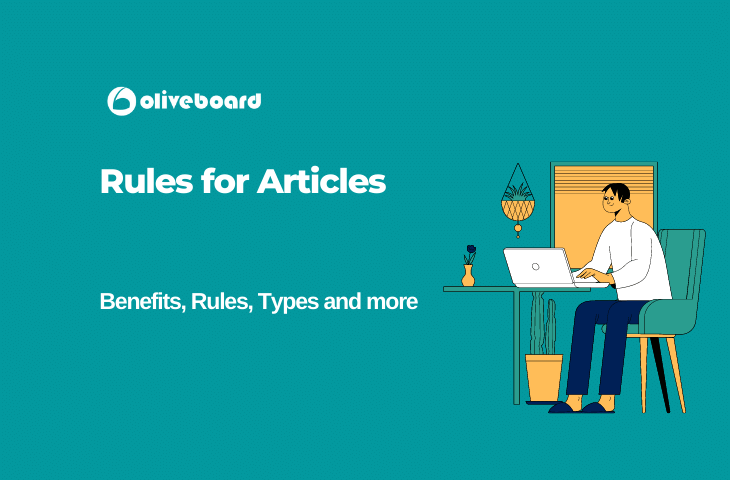Whether you’re studying for a job interview, preparing for any government recruitment exams, or want to improve your ability to communicate, nothing is more critical than brushing up on your English grammar. If you are preparing for the SSC, Banking, or Railways competitive exams, you must have a thorough understanding of English grammar as all these exams include questions based on the topic.
To assist our readers in preparing for the English section of the exams, we’ve put together this guide covering the definition, usage, types, examples, and Rules for Articles. We encourage all aspirants to study previous year’s papers and practice online mock tests to improve their overall command of the language and refresh their knowledge of English grammar.
What is an Article?
An article is a determiner that comes before a noun as a prefix. It helps determine whether the noun in any phrase or sentence is general or specific, and it determines the definiteness of a noun. Articles are also referred to as adjectives as they describe a noun.
Examples:
The room is clean.
In this sentence, ‘The’ before the noun room describes that we are talking about a particular room.
I gave him a pen, but he lost the pen.
Here, a pen indicates a random pen, but the pen states a particular pen.
Benefits of Articles
An article tells whether the noun is singular or plural, definite or indefinite, or positive or negative.
Examples:
I saw an elephant. (singular and random)
I saw the elephant again. (singular and specific)
I saw many elephants. (plural and random)
Rules for Articles in English
To make it easier for you, we’ve outlined below the rules for writing articles in English.
Articles
- Nouns
- Uncountable
- Definite (The)
- Uncountable
- Countable
- Plural
- Definite (The)
- Indefinite (no article)
- Plural
- Singular
- Definite (The)
- Indefinite (A/An)
Types of Articles
Based on the definiteness and generality of the noun, articles are of two types:
- Definite Article (The): It states that the noun is specific.
Example:
I saw the student stealing books.
- Indefinite Articles (A, An): These articles state the noun is generic or uncertain. ‘An’ is used before a noun with vowel (a, e, i, o, u) sound, and ‘A’ is used before consonant sound vowels.
Examples:
She is wearing a pink dress.
She has an apple and a banana.
Rules for Articles for Definite Article ‘The’
Rule 1: The article ‘the’ must be used before a singular or plural noun, which is specific and denotes a specific thing or person.
Examples:
The girl won the prize.
The doctor I visited was rude.
Rule 2: The article ‘the’ is used when the listener understands what the speaker is saying.
Example:
Did you finish all the assignments?
Rule 3: ‘The’ is used to refer to the entire class or group.
Example:
The teachers are always helpful.
Rule 4: ‘The’ is used for geographical locations.
Example:
The north pole and the south pole remain covered in snow.
Rule 5: ‘The’ is used for the uncountable nouns.
Example:
The temperature in the South Pole is freezing.
Rule 6: ‘The’ is used with geographical nouns, such as the names of rivers, oceans, groups of islands, mountains, lakes, countries with the united states, etc.
Examples:
The Ganges is a sacred river.
The English Channel is the longest river channel in the world.
Exceptions:
‘The’ cannot be used as a prefix with nouns, such as
- Names of continents, like South America, Africa, etc.
- Names of countries, states, or streets like India, London, Sydney, etc.
- Names of single mountains, lakes, bays, or islands, like Hudson Bay, etc.
- Names of languages like English, French, Hindi, etc.
- Names of sports, such as cricket, basketball, etc.
- Names of subjects like Maths, Economics, Geography, etc.
Rule 7: ‘The’ must be used when something is unique in the universe.
Example:
The Sun, The moon, The planet
Rules for Articles for Indefinite Article ‘A’ and ‘An’
Rule 1: The article ‘a’ is used before a noun with a consonant sound.
Examples:
The chair is occupied by a man.
She is a student at a university in Delhi.
Similarly, the article ‘an’ is used before the words with a vowel sound.
Examples:
She is an artist.
He is an innocent man.
Rule 2: ‘A’ or ‘An’ is always used with a singular common noun, whereas a plural common noun does not need an article or can use ‘the’ if that noun is specific.
Examples:
I ate an apple. (random single apple)
I ate apples. (many apples)
I ate the apple kept in the fridge. (particular apple)
Rule 3: ‘A’ or ‘An’ is used to change a proper noun to a common noun.
Example:
I am an Indian. (India is a proper noun whereas Indian is a common noun)
Rule 4: ‘A’ or ‘An’ is sometimes used to denote numbers.
Examples:
Seema has a doll.
Ram walks 5 km in an hour.
Rule 5: ‘A’ or ‘An’ is used before the descriptive adjectives.
Examples:
She is a beautiful girl.
What an amazing painting!
Rule 6: ‘A’ or ‘An’ is used with the non-specific determiners, such as few, most, lot, etc.
Examples:
There are a few students in the class.
Only a little milk is left.
Conclusion
We have included all important Rules for Articles in this guide as they play an important role in the objective section and the descriptive section of the competitive exams, such as reading comprehension, letter writing, or essay writing. We recommend our readers to practice thoroughly to do well in the English Language sections of the upcoming government examinations.
FAQs:
According to Rules for Articles, we don’t use articles with real nouns, plural nouns, and uncountable nouns.
There are two types of articles in the English language:
Definite Article: The
Indefinite Article: A, An
Articles are used before a noun according to the Rules for Articles in the English language.
